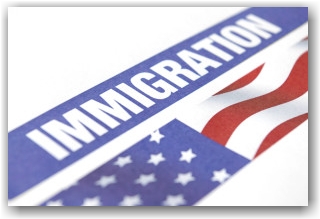Archive for the ‘L-1 Visa’ Category
Monday, November 21st, 2016
 The long-awaited final rule to modernize and improve several aspects of employment-based nonimmigrant and immigrant visa programs, in order to retain EB-1, EB-2 and EB-3 immigrant workers and high-skilled nonimmigrant workers, is moving forward and has made it through the OMB review process. It was published in the Federal Register on November 18, 2016 and will be effective in 60 days. USCIS has also amended regulations to better enable U.S. employers to hire and retain certain foreign workers who are beneficiaries of approved employment-based immigrant visa petitions and are waiting to become lawful permanent residents. This rule goes into effect on Jan. 17, 2017, just before President Obama leaves office.
The long-awaited final rule to modernize and improve several aspects of employment-based nonimmigrant and immigrant visa programs, in order to retain EB-1, EB-2 and EB-3 immigrant workers and high-skilled nonimmigrant workers, is moving forward and has made it through the OMB review process. It was published in the Federal Register on November 18, 2016 and will be effective in 60 days. USCIS has also amended regulations to better enable U.S. employers to hire and retain certain foreign workers who are beneficiaries of approved employment-based immigrant visa petitions and are waiting to become lawful permanent residents. This rule goes into effect on Jan. 17, 2017, just before President Obama leaves office.
Among other things, DHS is amending its regulations to:
- Clarifies and improves longstanding DHS policies and practices implementing sections of the American Competitiveness in the Twenty-First Century Act and the American Competitiveness and Workforce Improvement Act related to certain foreign workers, which will enhance USCIS’ consistency in adjudication.
- Better enables U.S. employers to employ and retain high-skilled workers who are beneficiaries of approved employment-based immigrant visa petitions (Form I-140 petitions) while also providing stability and job flexibility to these workers. The rule increases the ability of these workers to further their careers by accepting promotions, changing positions with current employers, changing employers and pursuing other employment opportunities. This means that you can use the previous employer’s I-140 petition to extend your H-1B with a new employer even if it is withdrawn (as long as it was withdrawn more than 180 days after approval), or in the event of the termination of the employer’s business. So, there is no I-140 portability; you will still need a new labor certification and I-140 petition to file your adjustment of status application.
- The final rule provides two grace periods of up to 10 days, consistent with those already available to individuals in 13 some nonimmigrant classifications, to individuals in the E-1, E-2, E-3, L-1, and TN classifications. The rule allows an initial grace period of up to 10 days prior to the start of an authorized validity period, allowing nonimmigrants in the above classifications a reasonable amount of time to enter the US and prepare to begin employment. The rule also allows a second grace period of up to 10 days after the end of an authorized validity period, which provides a reasonable amount of time to depart the US or take other actions to extend, change, or maintain lawful status.
- Establishes a grace period of up to 60 consecutive days during each authorized validity period for certain high-skilled nonimmigrant workers when their employment ends before the end of their authorized validity period provided their authorized stay is valid for at least 60 days after such cessation. If not, the grace period will end on the date the authorized date is set to expire. This will obviously enable own to more readily pursue new employment and an extension of their nonimmigrant status.
- The Final rule allows allows certain high-skilled individuals in the United States to apply for work authorization, given:
- They are the principal beneficiaries of an approved Form I-140 petition,
- An immigrant visa is not authorized for issuance for their priority date, and
- They can demonstrate compelling circumstances exist that justify DHS issuing an employment authorization document in its discretion. Such employment authorization may only be renewed in limited circumstances and only in one year increments.
- Automatically extends the employment authorization in the same category and validity of Employment Authorization Documents for up to 180 days from the date of the prior EAD’s expiry (EADs or Form I-766’s) or until djudication of the EAD nrenewal application, for certain individuals who apply on time to renew their EADs. The Form I-9 rule is also updated to permit an I-797 receipt notice to be accepted as a permissible I-9 document, in conjunction with the expired EAD, to re-verify the foreign national’s work authorization. This additional 180-day period will not apply to those categories that first require the approval of an underlying application before the EAD renewal can be adjudicated.
- Eliminates the regulatory provision that requires USCIS to adjudicate the Form I-765, Application for Employment Authorization, within 90 days of filing and that authorizes interim EADs in cases where such adjudications are not conducted within the 90-day timeframe.
- Clarifies various policies and procedures related to the adjudication of H-1B petitions, including, among other things, providing H-1B status beyond the six year authorized period of admission, determining cap exemptions and counting workers under the H-1B cap program.
For more information, please refer here for the Final Rule. If you have any questions, please contact our office. We will continue to keep you posted on the implementation of these new policies.
Tags: adjustment of status, E-3 visa, eb-1, eb-2, eb-3, Employment-Based immigrant visas, Grace Periods, Green-Cards, H-1B, High-Skilled Workers, I-140 Petition, Immigration News, L-1, O-1, tn, USCIS
Posted in Department Of Homeland Security (DHS), Department Of Labor (DOL), H-1B Visas, Immigrant Visas (I-140 Petitions), Immigration News, L-1 Visa, O-1 Visas, TNs, USCIS | Comments Off on USCIS Publishes Final Rule to Modernize Certain Employment-Based Immigrant and Nonimmigrant Visa Programs
Thursday, November 29th, 2012
 Much of the immigration challenges around case approval for entrepreneur start ups with USCIS has to do with the cases being reviewed by untrained officers, a lack of overall guidance for attorneys and practitioners concerning this casework, and a fundamental lack of “real world”, hands-on business knowledge on the part of USCIS. The agency has definitely released a nice looking mini-website marketing piece on the subject. We remain hopeful that the implementation of the below-listed changes will be the start of a new mindset for USCIS adjudication of entrepreneur start-up casework. In reviewing the information, we note that the Entrepreneur in Residence (EIR) team states that they have:
Much of the immigration challenges around case approval for entrepreneur start ups with USCIS has to do with the cases being reviewed by untrained officers, a lack of overall guidance for attorneys and practitioners concerning this casework, and a fundamental lack of “real world”, hands-on business knowledge on the part of USCIS. The agency has definitely released a nice looking mini-website marketing piece on the subject. We remain hopeful that the implementation of the below-listed changes will be the start of a new mindset for USCIS adjudication of entrepreneur start-up casework. In reviewing the information, we note that the Entrepreneur in Residence (EIR) team states that they have:
– Developed and deployed a training workshop for USCIS employment-based immigration officers that focuses on start up businesses and the environment for early-stage innovations;
– Trained a team of specialized immigration officers to handle entrepreneur and start up cases;
– Modified Request for Evidence templates for certain nonimmigrant visa categories to incorporate new types of relevant evidence into the adjudicative process; and
– Developed a plan for quarterly engagements with the entrepreneurial community to ensure that USCIS stays current with industry practices.
To sustain the momentum and build on the team’s accomplishments, USCIS indicated that they have extended the EIR project through April 2013. The project should be extended indefinitely if we are seriously courting foreign entrepreneurs to help jump-start the US economy. Among other things, the team states that it will expand its focus to immigrant visa pathways that may enable foreign entrepreneurs to start a business in the United States within current immigration law.
We are hopeful, in light of the economic challenges ahead of us in the USA at this time, that Congress will have a light bulb moment and pass legislation for a Start-up Visa and find a balanced and fair approach to increasing the visa alotment for STEM occupations without the punitive tradeoff approach of penalizing other visa classifications in return. For more information on the EIR program, we link here.
Tags: Congress, E-2 Visa, EB-5 Individual Visa, EB=5 Regional Center, Entrepreneurs in Residence, Foreign Entrepreneurs, Foreign Investors, H-1B Visa, Immigration Legislation, Immigration Reform, Job Creators, Start-up Visa, USCIS
Posted in Comprehensive Immigration Reform, Congress, Global Immigration, H-1B Visas, Immigration Legislation, Immigration News, L-1 Visa, USCIS | Comments Off on USCIS Develops Tools to Help Foreign Entrepreneurs Create and Grow Businesses in the USA
Friday, April 13th, 2012
 USCIS has partnered with business experts to ‘supposedly’ improve the way they approach the employment-based and high-skilled visa categories used by immigrant entrepreneurs. We’d really like to hope for the best on this that something major occurs as a result of opening up to public expertise and excellence in order to relax the restrictive business immigration environment that is prevalent at this time.
USCIS has partnered with business experts to ‘supposedly’ improve the way they approach the employment-based and high-skilled visa categories used by immigrant entrepreneurs. We’d really like to hope for the best on this that something major occurs as a result of opening up to public expertise and excellence in order to relax the restrictive business immigration environment that is prevalent at this time.
Director Alejandro Mayorkas kicked-off this innovative program, called the Entrepreneurs in Residence (EIR) initiative, with an Information Summit in Silicon Valley in February. Now, USCIS has entered a new phase of the initiative by bringing together the EIR Tactical Team. For 90 days this collaborative team, comprised of both USCIS employees and entrepreneurs from the private sector, will identify opportunities where USCIS can streamline pathways for foreign entrepreneurs. Team members began their work at USCIS in late March.
Last week, they traveled to the California Service Center and met with USCIS officers to discuss the visa categories most often used by immigrant entrepreneurs: H-1B, L-1 E-1, E-2, and O-1.
We direct you to Team Member bios here.
Tags: Alejandro Mayorkas, E-1 Visa, E-2 Visa, Entertainment Visas, Entrepreneurs in Residence Program, H-1B Visa, Immigrant Entrepreneurs, Immigration Compliance Group, Immigration News, Investor Visas, IT, L-1 visa, O-1 Visa, US Business Immigration, USCIS
Posted in H-1B Visas, L-1 Visa, O-1 Visas, USCIS | Comments Off on USCIS Announces the Entrepreneurs in Residence Tactical Team | Immigration Compliance Group
Monday, February 27th, 2012
 With H-1B filing season upon us as of April 2, 2012, we take this opportunity to remind you that although there has been slow but steady economic recovery over the last few years, the H-1B cap is expected to be reached much faster this year. This, coupled with a recent NFAP Policy Report Analysis released this month citing case denial rates of 17% with a staggering RFE (Request for Evidence) rate of 36%, sends a clear, “culture of no” message that USCIS is making it more difficult for skilled foreign nationals to work in the USA with increasing denial rates for both the H-1B and L-1 visa programs. All the more reason to be relying on experienced business immigration council for your case filings.
With H-1B filing season upon us as of April 2, 2012, we take this opportunity to remind you that although there has been slow but steady economic recovery over the last few years, the H-1B cap is expected to be reached much faster this year. This, coupled with a recent NFAP Policy Report Analysis released this month citing case denial rates of 17% with a staggering RFE (Request for Evidence) rate of 36%, sends a clear, “culture of no” message that USCIS is making it more difficult for skilled foreign nationals to work in the USA with increasing denial rates for both the H-1B and L-1 visa programs. All the more reason to be relying on experienced business immigration council for your case filings.
The NFAP report states, “Employers report the time lost due to the increase in denials and Requests for Evidence are costing them millions of dollars in project delays and contract penalties, while aiding competitors that operate exclusively outside the United States beyond the reach of USCIS adjudicators and U.S. consular officers.”
Small to medium-size companies and IT consultants and staffing agencies often bear the burden of these overbearing RFE’s. Working with smart immigration practitioners and preparing your case strategy in advance to address both your strengths and weaknesses, will pay off greatly. Here are some tips that we highly recommend be incorporated in your filings:
1) Incorporate a detailed brochure and description of the employer’s products or services and why you require a professional with a bachelor’s degree to perform the offered position. Include promotional materials, press releases or news articles to illustrate the nature of the business, new trends and growth factors in your business that substantiate the offered position.
2) Include a copy of your corporate tax return or financial statements to evidence profit and business stablity
3) Explain in detail why the position cannot be performed by an employee without a bachelor’s degree; i.e. is it standard in your industry? Provide detail (such as examples of work to be done) concerning the complexity of the position
4) Provide a real, detailed job description with the percentage of time spent on the duties of the position, the qualifications and special skills required to perform the job. Further explain any discretionary judgment that the employee will have in their job and other such areas of responsibility that are demanding or highly advanced
5) Provide evidence that you have a current and past practice of hiring bachelor’s degree employees for the subject position
6) IT and staffing agencies must be prepared to evidence the “employer-employee relationship” in H-1B offsite placement work situations by clearly evidencing the employer’s ability to “hire, pay, fire, supervise, or otherwise control the work of the employee. (based upon the January 8, 2010 Neufeld Memorandum).
If you’d like to set up a time to discuss your case with our office or to engage our services, please feel free to contact us.
Tags: DOL, F-1 Students, Global Mobility, H-1B, H-1B Job Descriptions, H-1B Visas, IT Consultants, L-1 visas, NFAP Policy Report, Specialty Workers, Staffing Agencies, USCIS
Posted in Department Of Homeland Security (DHS), Department Of Labor (DOL), H-1B Visas, L-1 Visa, Staffing Agencies, USCIS | Comments Off on Tips for H-1B Visa Petition Approvals
Thursday, February 23rd, 2012
 Top officials from the White House and the U.S. Citizenship and Immigration Services are in Silicon Valley for the week to solicit viewpoints and input from the start-up community on how the administration can improve the way it hands out visas to talented entrepreneurs who’ve landed funding to create new companies. While Obama is asking the question how he can improve the immigration process for foreign entrepreneurs, he’s stating to UniVision, “I’ve got 5 years left to solve immigration.” Our question is, must we really remain in the dark ages for 5 more years?
Top officials from the White House and the U.S. Citizenship and Immigration Services are in Silicon Valley for the week to solicit viewpoints and input from the start-up community on how the administration can improve the way it hands out visas to talented entrepreneurs who’ve landed funding to create new companies. While Obama is asking the question how he can improve the immigration process for foreign entrepreneurs, he’s stating to UniVision, “I’ve got 5 years left to solve immigration.” Our question is, must we really remain in the dark ages for 5 more years?
The article states that comprehensive immigration reform legislation continues to remain stalled in congress, as is specific bi-partisan legislation that attempts to address some of these start-up visa issues. So the Obama administration is left trying to make the most of the rules that it currently has on the books by re-interpreting a more accommodating implementation of those rules with fresh information gathered from the field. The consensus is that Obama lacks the conviction to use his executive authority in an election year on controversial immigration issues, and that this is simply PR. We say — this is exactly the time for him to use his executive authority anywhere he possibly can concerning immigration reform. We shall see if anything comes of this. More on this here.
Tags: Alejandro Mayorkas, Comprehensive Immgiration Reform, Congress, eb-5, Foreign Entrepreneurs, Global Mobility, H-1B, Immigration Reform, Investor Visas, IT Summit, L-1, SILICON VALLEY, Start-ups, USCIS, USCIS Director
Posted in Comprehensive Immigration Reform, Department Of Homeland Security (DHS), H-1B Visas, Immigration Legislation, Immigration News, L-1 Visa, USCIS | Comments Off on USCIS and White House Officials Head to Silicon Valley for IT Summit
Thursday, February 2nd, 2012
The Department of Homeland Security (DHS) this week announced a series of administrative reforms to help attract new businesses and new investment to the U.S. and ensure that the U.S. has the most skilled workforce in the world. These reforms are to take place over a period of time.
Leaders in the private sector launched the Startup America Partnership, an independent alliance of entrepreneurs, corporations, universities, foundations, and other leaders, joining together to fuel innovative, high-growth U.S. start-ups. Within just one year, the Partnership has mobilized to make over $1 billion in business services available to a national network that will serve as many as 100,000 start-ups over the next three years.
For more on this: http://www.whitehouse.gov/economy/business/startup-america
Tags: Department Of Homeland Security (DHS), E-3 visa, F-1 Visas, Global Mobility, H-1B Visa, H-4 visa, Immigration Compliance Group, Immigration News, Immigration Reform, International Students, L-1 visa, OPT, Startup America Partnership
Posted in Comprehensive Immigration Reform, H-1B Visas, Immigration News, L-1 Visa | Comments Off on DHS Reforms To Attract And Retain Highly Skilled Immigrants; Expand OPT Eligibility, H-4 dependents work authorization & more
Tuesday, March 8th, 2011
Our March 2011 news is now available. You can access our Immigration News here and our I-9 Compliance Newsletter here. Should you wish to discuss your immigration case with us, we can be contacted at info@immigrationsolution.net or by phone at 562 612.3996.
We have a volume of free information on our websites that includes newsletters, news flashes, podcasts, blog, and articles. Please feel free to sign up on our website: www.immigrationsolution.net to receive our information through email or iTUNES.
Tags: E-Verify News, I-9 News, Immigration News
Posted in Department Of Homeland Security (DHS), Department of State, Foreign Nurses, Healthcare, I-9/E-Verify News, ICE, ICG Podcasts, Immigration Legislation, Immigration News, L-1 Visa, Nurses, USCIS | Comments Off on I-9, E-Verify and Immigration News for March 2011
Monday, January 3rd, 2011
Over the last year, employers have continued to experience unannounced site visits by U.S. Citizenship and Immigration Services’ Office of Fraud Detection and National Security (FDNS), and it is expected that site visits will increase in 2011. FDNS conducts site inspections to verify the information that employers provide in their immigration petitions. Most recently, site visits have focused on approved H-1B, L-1 and some O-1 petitions. Some employers have reported receiving multiple site visits pertaining to separate petitions and foreign workers.
In this series, we will address questions and inquiries that we have received pertaining to USCIS site visits. If your company is contacted by an FDNS officer, you should call your designated Immigration Solutions professional immediately to discuss options, including the possibility of having counsel present during a site visit.
1) Why is USCIS making employer site visits? Site visits are conducted as part of a Benefits Fraud Assessment (BFA). BFAs are initiatives that review specific immigration programs – such as the H-1B or L-1 program – to determine the incidence of fraud in that particular program. A BFA typically lasts for several months. During this time, USCIS will randomly select a large number of petitions or applications for benefits in the particular category being assessed. These cases are assigned to FDNS officers, who visit the premises of sponsoring employers to verify the existence of the employer, the validity of the information the employer has provided in an immigration petition, and whether sponsored foreign nationals are working in compliance with the terms of their admission to the United States.
In addition to verifying the validity of data contained in an immigration petition, FDNS officers use information collected during site visits to help USCIS develop a fraud detection database. FDNS officers gather information to build profiles of the types of companies that have records of good faith use of immigration programs and records of immigration compliance, and also to identify factors that could indicate fraud.
2) Does USCIS give advance notice of a site visit? Not necessarily. In most cases, officers from the FDNS unit will arrive at the worksite unannounced, though occasionally an officer may call the company to inform it of an impending visit.
3) Can your attorney be present during the site visit? You can ask to have counsel present during the site visit, especially because your attorney has submitted a Form G-28 notice of appearance of attorney, confirming that the company has legal representation in connection with each petition it files. FDNS officers will not typically reschedule a site visit to accommodate the presence of an attorney, but may agree to allow counsel to be present by phone. In the alternative, you may contact your Immigration Solutions with questions during a site visit. If the officer is resistant, you should explain that having the company’s immigration counsel present or available by phone will help the employer respond fully and accurately to the officer’s questions and requests for information.
::::::::::::::::::::::::::::::::::
As always, we welcome your feedback. If you are interested in becoming an Immigration Solutions client, please call our office at 562 612.3996 and request a consultation. We handle a broad range of business related immigration matters and have an active employer compliance practice and consult on proper I-9 (Employment Eligibility Verification) best practices, auditing, training, and work with our clients to develop compliant immigration policies and procedures. We offer these services, as well, to government contractors and advise on FAR E-Verify enrollment and compliance issues. Visit our new I-9 Employer Resource center here
Tags: Benefits Fraud Assessment, E-Verify, Employer Compliance, FDNS, H-1B, L-1, SSA No-Match, USCIS SITE VISITS, Worksite Enforcement
Posted in Employer Site Visits, Federal Contractors, H-1B Visas, I-9/E-Verify News, ICE, L-1 Visa, USCIS | Comments Off on USCIS Employer Site Visits | Part 1
Wednesday, December 8th, 2010
USCIS has released FAQs on PL 111-230 that requires certain employers to pay additional fees for L-1 and H-1B initial and change of employer filings if the employer has 50 or more US employees with at least 50% of whom are in H-1B, L-1A or L-1B status.
The additional fee for an H-1Bs is $2,000 and $2,250 for L-1A and L-1B employees. The fee does not apply to extension requests filed by the same employer for the same employee.
The term “employer” for purposes of implementing PL 111-230 is found at 8 CFR 214.2(h)(4)(ii) and states…A person firm or corporation, contractor or other association or organization in the USA which:
- engages a person to work within the USA
- has an employer-employee relationship with respect to employees under this part, as indicated by the fact that it may hire, pay, fire, supervise or otherwise control the work of any such employee; and
- has an Internal Revenue Service Tax ID #
Note that the employer definition above does not extend or authorize its application beyond PL 1111-230 and the H-1B rules and regulations. Additionally, all employees, whether full-time or part-time, will count towards the calculation of whether an employer is subject to the new fee. This fee does not apply to dependents in H-4 and L-2 classification.
We link to the FAQs
Should you have any questions concerning this or wish to retain our office or request a proposal, please contact us.
Tags: H-1B, L-1A, L-1B, PL 111-230, USCIS Fee Increase
Posted in H-1B Visas, L-1 Visa, USCIS | Comments Off on USCIS Releases FAQs on H-1B and L-1 PL 111-230 Fees
Tuesday, November 23rd, 2010
In a November 18th Press Release the Ambassador announced a more convenient visa application processes, effective immediately, and that the U.S. Embassy in New Delhi and Consulates General in Mumbai, Chennai, Kolkata and Hyderabad will now accept visa applications from across India at all visa facilities, regardless of the applicant’s home address or city of residence. This is part of
Mission India’s ongoing effort to facilitate legitimate travel to the United States.
Following the opening of Consulate General Hyderabad in 2008, the U.S. Mission has looked for ways to best capture
the dynamism of India’s growth across the nation. As a result, they have redesigned the consular districts, as follows:
Embassy Delhi: Bihar, Delhi, Haryana, Himachal Pradesh, Jammu and Kashmir, Punjab, Rajasthan, Uttarakhand, Uttar Pradesh, Bhutan;
Consulate Mumbai: Goa, Gujarat, Madhya Pradesh, Maharashtra, Diu and Daman, and Dadra and Nagar Haveli;
Consulate Hyderabad: Andhra Pradesh, Orissa;
Consulate Chennai: Karnataka, Kerala, Puducherry, Lakshadweep, Tamil Nadu, Andaman and Nicobar Islands;
Consulate Kolkata: Arunachal Pradesh, Assam, Chhattisgarh, Jharkhand, Manipur, Meghalaya, Mizoram, Nagaland,
Sikkim, Tripura, West Bengal
::::::::::::::::
If you are enjoying our blog posts, please sign up to receive our free news and information here where you can also peruse our Article Directory. Our new Employer Compliance Resource Center provides guidance on I-9 processing, training and worksite compliance. You can access it here
Tags: H-1B Visas, India Consulates, India Visa Applications, L-1 visas, US Embassy in New Delhi
Posted in Department of State, H-1B Visas, L-1 Visa, Staffing Agencies | Comments Off on India Consulates Switch to More Convenient Visa Application Process
 The long-awaited final rule to modernize and improve several aspects of employment-based nonimmigrant and immigrant visa programs, in order to retain EB-1, EB-2 and EB-3 immigrant workers and high-skilled nonimmigrant workers, is moving forward and has made it through the OMB review process. It was published in the Federal Register on November 18, 2016 and will be effective in 60 days. USCIS has also amended regulations to better enable U.S. employers to hire and retain certain foreign workers who are beneficiaries of approved employment-based immigrant visa petitions and are waiting to become lawful permanent residents. This rule goes into effect on Jan. 17, 2017, just before President Obama leaves office.
The long-awaited final rule to modernize and improve several aspects of employment-based nonimmigrant and immigrant visa programs, in order to retain EB-1, EB-2 and EB-3 immigrant workers and high-skilled nonimmigrant workers, is moving forward and has made it through the OMB review process. It was published in the Federal Register on November 18, 2016 and will be effective in 60 days. USCIS has also amended regulations to better enable U.S. employers to hire and retain certain foreign workers who are beneficiaries of approved employment-based immigrant visa petitions and are waiting to become lawful permanent residents. This rule goes into effect on Jan. 17, 2017, just before President Obama leaves office.




